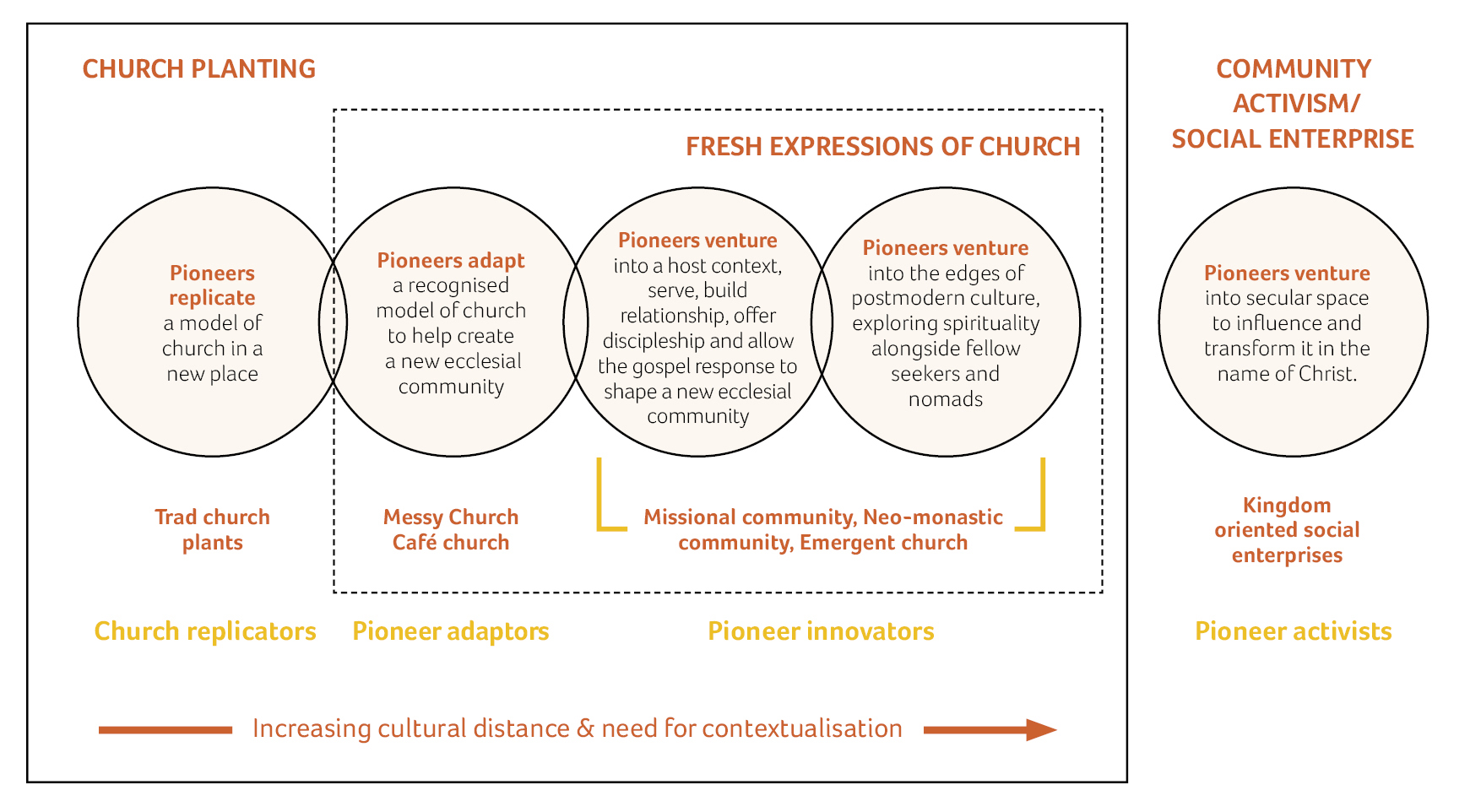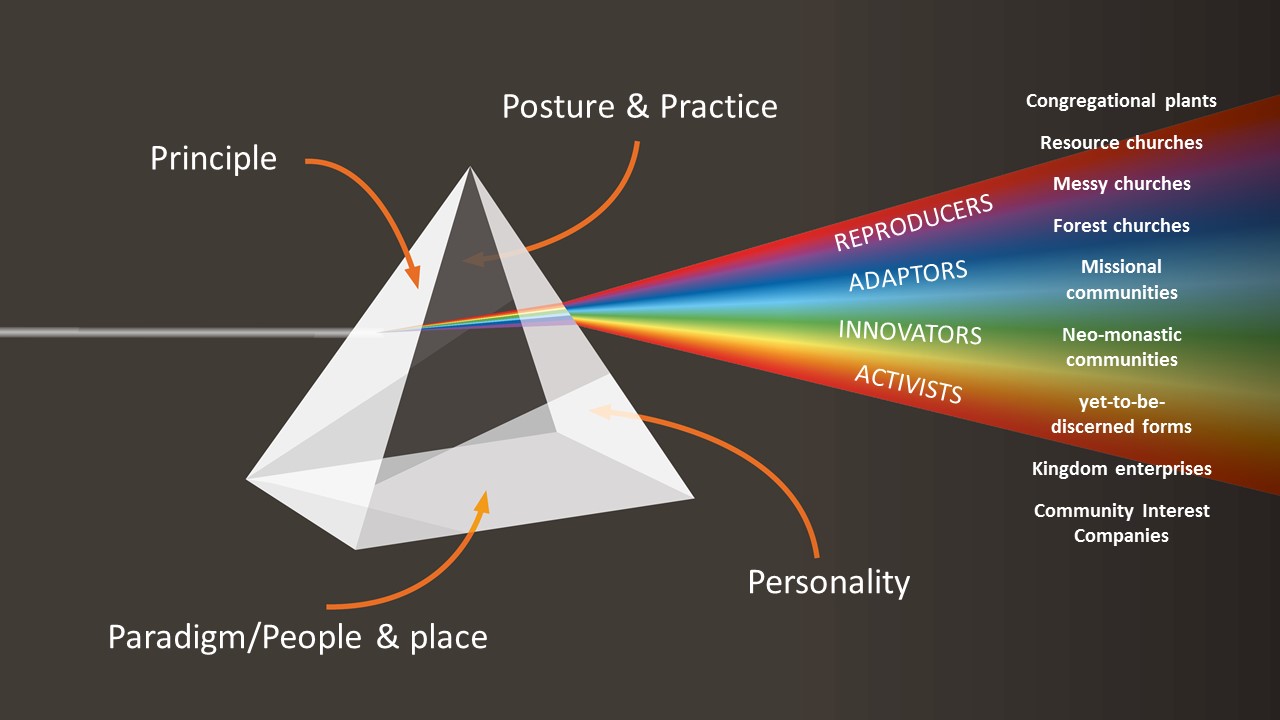“The spectrum is what happens when the church, and individual leaders within it, engage in mission in their context.”
The creators of the Pioneer Spectrum reflect on the popularity and the flaws of this diagram and how they have been working to develop it into a useful missional tool.
by Paul Bradbury and Tina Hodgett,
Since the pioneer spectrum was published in 2018 it has been widely shared, discussed and used.
A good diagram works when it acts as a lens to help people understand their reality and therefore as a tool to enable engagement with reality. Any diagram however flirts with the danger of being seen as a definition of reality.
A diagram has a metaphorical quality, it both ‘is and is not’ a representation of people’s experience.
The degree to which a diagram or metaphor ‘fits’ with people’s experience is a measure of its imaginary power – however despite this there is an edge beyond which the metaphor ceases to ‘work’.

The original pioneer spectrum diagram has certainly been useful for people. But there are limitations to it.
In particular some people feel that there is an implicit sense of progression from left to right making innovators and activists somehow ‘better’ than reproducers and adaptors.
The pioneer types in their overlapping rings also imply a kind of fixed nature of the vocation, when, as pioneers tell us, the reality is much more fluid. Pioneers may well feel they inhabit one pioneer type primarily but in terms of their ministry often find they are operating in other types as well.
But most of all, the original spectrum diagram loses so much that was involved in its creation. There are a whole host of reflections on the theology, missiology and practice of pioneers that went alongside the discernment of the types, which sits alongside the diagram and which lends it depth and nuance.
We have continued to work with the idea of the pioneer spectrum, working in particular on developing it into an interactive tool that can be used by pioneers discerning their vocation and also by teams looking at mission strategy and resourcing.
In the course of this another way of seeing the spectrum emerged. Here the spectrum is what happens when the church, and individual leaders within it, engage in mission in their context.
The diagram imagines this as light being refracted through a prism of four lenses.
Three of these lenses (here numbered 1–3) describe what the church brings to mission, the fourth (and most critical lens) helps describe the context and is therefore the lens through which the light leaves the prism. We define these lenses as:
- Principle – this is the lens of our theological assumptions; for example, our beliefs and convictions about God and how God can be known, about the nature of the church and its relationship with the Kingdom of God and the world. These have a huge impact on our practice (though of course they are also informed and shaped by practice).
- Posture and Practice – this is the lens that describes our missional stance in the world and our practice within it. For example, is our approach about creating church, or growing the Kingdom? How do we create church? Do we begin with a congregation from the start? Or enable something new to emerge over time? What is the relationship between our ministry and our tradition?
- Personality – this lens explores how people are wired, particularly in relationship to missional leadership. Is leadership directive or facilitative? Is it more about application or innovation? What are the preferred metrics of success? What relationship with the established church does the leader feel most comfortable with?
- Paradigm/People and Place – this lens is really a composite of two lenses:
- Paradigm – this refers to the cultural paradigm(s) that shape a context. In what ways is a postmodern, modern or premodern mindset and worldview expressed in this place?
- People & Place – this refers to the basic information about a context. What type of people live there? Young, old, rich, poor, educated, less-educated etc? It also invites reflections on diversity and political convictions.

When the church faithfully seeks to express the gospel in all her diversity, within the bewildering diversity of contexts that exist and continue to emerge in our day, a diversity of ministries and forms emerge.
Some of the vocations that we have identified, and some of the forms we see, are common enough that we can begin to name them. But we need to be careful not to preserve these as though they were fixed. They need to be held lightly and with provisionality.
Since we first created the spectrum the landscape has changed significantly; we are living in a time of the church’s life when significant shifts are happening at pace, and we imagine needing to re-draw the spectrum again before long in response to what is happening on the ground.
We have also put in an expression we call ‘yet-to-be discerned forms’ to invite a stance of patience and discernment as pioneers engage with their contexts and with the Holy Spirit in the growth of the Kingdom and the formation of new Christian communities.
At the heart of this way of seeing the spectrum is context. The spectrum is what happens when the church is sent by Christ in the power of the Holy Spirit to love and bless a particular community in his name.
As long as there are new contexts and new expressions of culture there will be new expressions of the Kingdom and Christian community. And new ways of seeing what God is doing so we can participate as best we can in his work of mission in the world.
More from the blog
Coming full circle
Pioneering chaplain Mark Nam’s journey to winning a National Diversity Award
Church, mission, politics and being a Christian nation: corruption, co-option or collaboration?
This week, a BBC article explored Tommy Robinson supporters turning to church. It shines a spotlight on some tricky questions…